Establishment of Efficient Somatic Embryo Maturation System of Pinus elliottii
Abstract
1. Introduction
2. Results
2.1. Effect of Genotype on Callus Induction of Pinus elliottii
2.2. Suspension Culture of Embryogenic Callus of Pinus elliottii
2.3. Induction of Somatic Embryo Maturation in Pinus elliottii
- (1)
- Pretreatment and Liquid–Solid Media Enhance Embryo Maturation Efficiency
- (2)
- PSK and COS Boost Embryo Maturation Efficiency
- (3)
- Activated Carbon Enhances Embryo Maturation Efficiency
2.4. Somatic Embryo Germination and Seedling Transplantation of Pinus elliottii
3. Discussion
3.1. Genotypes Affect the Efficiency of Embryonic Callus Induction
3.2. Exogenous Phytohormones Affect Somatic Embryo Maturation
3.3. PSK, COS Can Induce Somatic Embryo Maturation
3.4. Activated Carbon Can Induce Somatic Embryo Maturation and Germination
4. Materials and Methods
4.1. Plant Materials
4.2. Culture Conditions
4.3. Callus Induction Study
4.4. Optimization of Suspension Culture Conditions for Embryogenic Callus
4.5. Optimization of Maturation Induction Conditions for Pinus elliottii
4.6. Somatic Embryo Germination and Transplantation
4.7. Data Statistics and Analysis
5. Conclusions
Author Contributions
Funding
Data Availability Statement
Conflicts of Interest
Abbreviations
| ABA | abscisic acid |
| PEG | polyethylene glycol |
| NH4+ | ammonia |
| NO3− | nitrate |
| 2,4-D | 2,4-dichlorophenoxyacetic acid |
| BA | 6-benzylaminopurine |
| KT | kinetin |
| PSK | Phytosulfokine |
| COS | Chitooligosaccharide |
| AC | Activated Charcoal |
| EC | embryogenic callus |
| NEC | non-embryogenic callus |
| ROS | reactive oxygen species |
| H2O2 | hydrogen peroxide |
| PRX | peroxidase |
| NO | nitric oxide |
| IAA | 1H-Indole-3-acetic acid |
References
- Wen, X.; Kuang, Y.; Shi, M.; Li, H.; Luo, Y.; Deng, R. Biology of Hylobitelus xiaoi (Coleoptera: Curculionidae), a New Pest of Slash Pine, Pinus elliottii. J. Econ. Entomol. 2004, 97, 1958–1964. [Google Scholar] [CrossRef] [PubMed]
- Junkes, C.F.D.O.; Duz, J.V.V.; Kerber, M.R.; Wieczorek, J.; Galvan, J.L.; Fett, J.P.; Fett-Neto, A.G. Resinosis of young slash pine (Pinus elliottii Engelm.) as a tool for resin stimulant paste development and high yield individual selection. Ind. Crops Prod. 2019, 135, 179–187. [Google Scholar] [CrossRef]
- Chapman, A.; Blervacq, A.; Tissier, J.; Delbreil, B.; Vasseur, J.; Hilbert, J. Cell wall differentiation during early somatic embryogenesis in plants. I. Scanning and transmission electron microscopy study on embryos originating from direct, indirect, and adventitious pathways. Can. J. Bot. 2000, 78, 816–823. [Google Scholar]
- Stasolla, C.; Kong, L.; Yeung, E.C.; Thorpe, T.A. Maturation of Somatic Embryos in Conifers: Morphogenesis, Physiology, Biochemistry, and Molecular Biology. In Vitr. Cell. Dev. Biol. Plant 2002, 38, 93–105. [Google Scholar] [CrossRef]
- Lelu-Walter, M.A.; Klimaszewska, K.; Miguel, C.; Aronen, T.; Trontin, J. Somatic Embryogenesis for More Effective Breeding and Deployment of Improved Varieties in Pinus Spp.: Bottlenecks and Recent Advances; Springer International Publishing: Cham, Switzerland, 2016. [Google Scholar]
- Abrahamsson, M.; Valladares, S.; Larsson, E.; Clapham, D.; von Arnold, S.; Sveriges, L. Patterning during somatic embryogenesis in Scots pine in relation to polar auxin transport and programmed cell death. Plant Cell Tissue Organ Cult. 2012, 109, 391–400. [Google Scholar] [CrossRef]
- Helmersson, A.; von Arnold, S.; Sveriges, L. Embryogenic cell lines of Juniperus communis; easy establishment and embryo maturation, limited germination. Plant Cell Tissue Organ Cult. 2009, 96, 211–217. [Google Scholar] [CrossRef]
- Park, Y.S.; Lelu-Walter, M.A.; Harvengt, L.; Trontin, J.F.; MacEacheron, I.; Klimaszewska, K.; Bonga, J.M. Initiation of somatic embryogenesis in Pinus banksiana, P. strobus, P. pinaster, and P. sylvestris at three laboratories in Canada and France. Plant Cell Tissue Organ Cult. 2006, 86, 87–101. [Google Scholar] [CrossRef]
- Lelu, A.M.; Bastien, C.; Drugeault, A.; Gouez, M.L.; Klimaszewska, K. Somatic embryogenesis and plantlet development in Pinus sylvestris and Pinus pinaster on medium with and without growth regulators. Physiol. Plant. 1999, 105, 719–728. [Google Scholar] [CrossRef]
- Niskanen, A.M.; Lu, J.; Seitz, S.; Keinonen, K.; Von Weissenberg, K.; Pappinen, A. Effect of parent genotype on somatic embryogenesis in Scots pine (Pinus sylvestris). Tree Physiol. 2004, 24, 1259–1265. [Google Scholar] [CrossRef]
- Chen, Y.; Fei, Q.; Xia, X.; Ke, X.; Ye, J.; Zhu, L. Pinus massoniana somatic embryo maturation, mycorrhization of regenerated plantlets and its resistance to Bursaphelenchus xylophilus. Front. Plant Sci. 2023, 14, 1130471. [Google Scholar] [CrossRef]
- Peng, C.; Gao, F.; Wang, H.; Shen, H.; Yang, L. Optimization of maturation process for somatic embryo production and cryopreservation of embryogenic tissue in Pinus koraiensis. Plant Cell Tissue Organ Cult. 2021, 144, 185–194. [Google Scholar] [CrossRef]
- Pullman, G.S.; Bucalo, K. Pine somatic embryogenesis: Analyses of seed tissue and medium to improve protocol development. New For. 2014, 45, 353–377. [Google Scholar] [CrossRef]
- Xia, X.; Yang, F.; Ke, X.; Chen, Y.; Ye, J.; Zhu, L. Somatic embryogenesis of masson pine (Pinus massoniana): Initiation, maturation and genetic stability analysis at SSR loci. Plant Cell Tissue Organ Cult. 2021, 145, 667–677. [Google Scholar] [CrossRef]
- Nie, S.; Yan, Y.; Wang, Y.; Liu, S.; Guo, W.; Yang, L.; Shen, H. Proper doses of brassinolide enhance somatic embryogenesis in different competent Korean pine cell lines during embryogenic callus differentiation. Front. Plant Sci. 2024, 15, 1330103. [Google Scholar] [CrossRef]
- Hudec, L.; Konrádová, H.; Hašková, A.; Lipavská, H.; Cooke, J. Norway spruce embryogenesis: Changes in carbohydrate profile, structural development and response to polyethylene glycol. Tree Physiol. 2016, 36, 548–561. [Google Scholar] [CrossRef] [PubMed]
- Tremblay, L.F.C.C.; Tremblay, F.M. Carbohydrate requirements for the development of black spruce (Picea mariana (Mill.) B.S.P.) and red spruce (P. rubens Sarg.) somatic embryos. Plant Cell Tissue Organ Cult. 1991, 27, 95–103. [Google Scholar] [CrossRef]
- Varis, S.; Tikkinen, M.; Välimäki, S.; Aronen, T. Light Spectra during Somatic Embryogenesis of Norway Spruce—Impact on Growth, Embryo Productivity, and Embling Survival. Forests 2021, 12, 301. [Google Scholar] [CrossRef]
- Chen, S.; Chen, S.; Chen, F.; Wu, T.; Wang, Y.; Yi, S. Somatic embryogenesis in mature zygotic embryos of Picea likiangensis. Biológia 2010, 65, 853–858. [Google Scholar] [CrossRef]
- STASOLLA, C.; YEUNG, E.C. Recent advances in conifer somatic embryogenesis: Improving somatic embryo quality. Plant Cell Tissue Organ Cult. 2003, 74, 15–35. [Google Scholar] [CrossRef]
- Aronen, T.; Pehkonen, T.; Ryynanen, L. Enhancement of somatic embryogenesis from immature zygotic embryos of Pinus sylvestris. Scand. J. For. Res. 2009, 24, 372–383. [Google Scholar] [CrossRef]
- Lelu-Walter, M.; Bernier-Cardou, M.; Klimaszewska, K. Clonal plant production from self- and cross-pollinated seed families of Pinus sylvestris (L.) through somatic embryogenesis. Plant Cell Tissue Organ Cult. 2008, 92, 31–45. [Google Scholar] [CrossRef]
- Do Nascimento, A.M.M.; Polesi, L.G.; Back, F.P.; Steiner, N.; Guerra, M.P.; Castander-Olarieta, A.; Moncaleán, P.; Montalbán, I.A. The Chemical Environment at Maturation Stage in Pinus spp. Somatic Embryogenesis: Implications in the Polyamine Profile of Somatic Embryos and Morphological Characteristics of the Developed Plantlets. Front. Plant Sci. 2021, 12, 771464. [Google Scholar] [CrossRef] [PubMed]
- Li, F.; Yao, J.; Hu, L.; Chen, J.; Shi, J. Multiple Methods Synergistically Promote the Synchronization of Somatic Embryogenesis Through Suspension Culture in the New Hybrid Between Pinus elliottii and Pinus caribaea. Front. Plant Sci. 2022, 13, 857972. [Google Scholar] [CrossRef] [PubMed]
- Castander-Olarieta, A.; Moncaleán, P.; Pereira, C.; Pěnčík, A.; Petřík, I.; Pavlović, I.; Novák, O.; Strnad, M.; Goicoa, T.; Ugarte, M.D.; et al. Cytokinins are involved in drought tolerance of Pinus radiata plants originating from embryonal masses induced at high temperatures. Tree Physiol. 2021, 41, 912–926. [Google Scholar] [CrossRef]
- Yang, F.; Xia, X.; Ke, X.; Ye, J.; Zhu, L. Somatic embryogenesis in slash pine (Pinus elliottii Engelm): Improving initiation of embryogenic tissues and maturation of somatic embryos. Plant Cell Tissue Organ Cult. 2020, 143, 159–171. [Google Scholar] [CrossRef]
- Jain, S.M.; Dong, N.; Newton, R.J. Somatic embryogenesis in slash pine (Pinus elliottii) from immature embryos cultured in vitro. Plant Sci. 1989, 65, 233–241. [Google Scholar] [CrossRef]
- Fei, Q.; Chen, Y.; Ke, X.; Ye, J.; Zhu, L. Somatic embryogenesis of slash pine (Pinus elliottii Engelm.): Initiation, maturation, germination and mycorrhization of regenerated plantlets. Plant Cell Tissue Organ Cult. 2024, 157, 65. [Google Scholar] [CrossRef]
- Newton, R.J.; Marek-Swize, K.A.; Magallanes-Cedeno, M.E.; Dong, N.; Sen, S.; Jain, S.M. Somatic Embryogenesis in Slash Pine (Pinus elliottii Engelm.); Springer Nature: Berlin/Heidelberg, Germany, 1995; pp. 183–195. [Google Scholar]
- Jiwen, H.; Wenbing, G.; Leping, D.; Suiying, Z.; Weimin, W.; Fencheng, Z.; Ting, H.; Huishan, W.; Yiliang, L.; Fangyan, L. Somatic embryogenesis and plantlet regeneration in Pinus elliottii and its hybrids. J. South China Agric. Univ. 2019, 40, 107–115. [Google Scholar]
- Shin, U.; Ch, R.; Kang, H. In vitro and Ex vitro Propagations of Astilboides tabularis (Hemsl.) Engl. as a Rare and Endangered Species. J. Hortic. 2019, 6, 1–5. [Google Scholar]
- Park, Y. Implementation of conifer somatic embryogenesis in clonal forestry: Technical. requirements and deployment considerations. Ann. For. Sci. 2002, 59, 651–656. [Google Scholar] [CrossRef]
- Hargreaves, C.L.; Reeves, C.B.; Find, J.I.; Gough, K.; Josekutty, P.; Skudder, D.B.; Maas, S.A.V.D.; Sigley, M.R.; Menzies, M.I.; Low, C.B.; et al. Improving initiation, genotype capture, and family representation in somatic embryogenesis of Pinus radiata by a combination of zygotic embryo maturity, media, and explant preparation. Can. J. For. Res. 2009, 39, 1566–1574. [Google Scholar] [CrossRef]
- Montalbán, I.A.; Setién-Olarra, A.; Hargreaves, C.L.; Moncaleán, P. Somatic embryogenesis in Pinus halepensis Mill.: An important ecological species from the Mediterranean forest. Trees 2013, 27, 1339–1351. [Google Scholar] [CrossRef]
- Nunes, S.; Marum, L.; Farinha, N.; Pereira, V.T.; Almeida, T.; Sousa, D.; Mano, N.; Figueiredo, J.; Dias, M.C.; Santos, C. Somatic embryogenesis of hybrid Pinus elliottii var. elliottii × P. caribaea var. hondurensis and ploidy assessment of somatic plants. Plant Cell Tissue Organ Cult. 2018, 132, 71–84. [Google Scholar] [CrossRef]
- Yang, X.; Zhang, X. Regulation of Somatic Embryogenesis in Higher Plants. Crit. Rev. Plant Sci. 2010, 29, 36–57. [Google Scholar] [CrossRef]
- Elhiti, M.; Stasolla, C. Somatic Embryogenesis: The Molecular Network Regulating Embryo Formation; Springer India: New Delhi, India, 2016. [Google Scholar]
- Garcia, C.; Furtado De Almeida, A.; Costa, M.; Britto, D.; Valle, R.; Royaert, S.; Marelli, J. Abnormalities in somatic embryogenesis caused by 2,4-D: An overview. Plant Cell Tissue Organ Cult. 2019, 137, 193–212. [Google Scholar] [CrossRef]
- Ming, L.; Shuxiang, W.; Daling, F. The Advance of Plant Somatic Embryogenesis and Development. Chin. Agric. Sci. Bull. 2011, 27, 237–241. [Google Scholar]
- Brookbank, B.P.; Patel, J.; Gazzarrini, S.; Nambara, E. Role of Basal ABA in Plant Growth and Development. Genes 2021, 12, 1936. [Google Scholar] [CrossRef] [PubMed]
- Kong, L.; von Aderkas, P. Genotype effects on ABA consumption and somatic embryo maturation in interior spruce (Picea glauca × engelmanni). J. Exp. Bot. 2007, 58, 1525–1531. [Google Scholar] [CrossRef]
- Ali, F.; Qanmber, G.; Li, F.; Wang, Z. Updated role of ABA in seed maturation, dormancy, and germination. J. Adv. Res. 2022, 35, 199–214. [Google Scholar] [CrossRef]
- Xu, Y.; Shang, W.; Li, L.; Song, Y.; Wang, G.; Shi, L.; Shen, Y.; Sun, Y.; He, S.; Wang, Z. Transcriptome Landscape Analyses of the Regulatory Network for Zygotic Embryo Development in Paeonia ostii. Int. J. Mol. Sci. 2023, 24, 10715. [Google Scholar] [CrossRef]
- Rai, M.K.; Shekhawat, N.S.; Harish; Gupta, A.K.; Phulwaria, M.; Ram, K.; Jaiswal, U. The role of abscisic acid in plant tissue culture: A review of recent progress. Plant Cell Tissue Organ Cult. 2011, 106, 179–190. [Google Scholar] [CrossRef]
- Bozhkov, P.V.; Filonova, L.H.; von Arnold, S. A key developmental switch during Norway spruce somatic embryogenesis is induced by withdrawal of growth regulators and is associated with cell death and extracellular acidification. Biotechnol. Bioeng. 2002, 77, 658–667. [Google Scholar] [CrossRef] [PubMed]
- Yang, X.; Chang, M.; Yang, N.; Zhang, Q.; Ge, Y.; Zhou, H.; Li, G.; Yang, Q. ABA exerts a promotive effect on the early process of somatic embryogenesis in Quercus aliena Bl. Plant Physiol. Bioch. 2024, 214, 108969. [Google Scholar] [CrossRef] [PubMed]
- Igasaki, T.F.A.F.; Akashi, N.; Ujino Ihara, T.; Matsubayashi, Y.; Sakagami, Y.; Shinohara, K. Phytosulfokine stimulates somatic embryogenesis in Cryptomeria japonica. Plant Cell Physiol. 2003, 44, 1412–1416. [Google Scholar] [CrossRef]
- Yanjuan, Z.; Tielong, C.; Yanwei, Z.; Shuang, W.; Pengkai, W.; Jisen, S.; Jinhui, C. Effect of PSK on growth and development of Liriodendron hybrids suspension cultured cells. J. Nanjing For. Univ. 2014, 38, 171–174. [Google Scholar]
- Luo, Q.; Hu, S.; Deng, Z.; Gu, Z.; Liu, Q.; Zhou, G.; Du, Q.; Yang, C. Plant peptide hormone phytosulfokine promotes embryo development of mass in Pinus massoniana. Plant Cell Tissue Organ Cult. 2024, 158, 58. [Google Scholar] [CrossRef]
- Stelmach, K.; Grzebelus, E. Plant regeneration from protoplasts of Pastinaca sativa L. via somatic embryogenesis. Plant Cell Tissue Organ Cult. 2023, 153, 205–217. [Google Scholar] [CrossRef]
- Lee, H.; Han, J.; Bae, E.; Jie, E.Y.; Kim, S.W.; Kwon, H.J.; Lee, H.S.; Yeon, S.; Murthy, H.N.; Park, S. Response surface methodology mediated optimization of phytosulfokine and plant growth regulators for enhanced protoplast division, callus induction, and somatic embryogenesis in Angelica Gigas Nakai. BMC Plant Biol. 2024, 24, 527. [Google Scholar] [CrossRef]
- Hao, Z.; Wu, H.; Zheng, R.; Li, R.; Zhu, Z.; Chen, Y.; Lu, Y.; Cheng, T.; Shi, J.; Chen, J. The plant peptide hormone phytosulfokine promotes somatic embryogenesis by maintaining redox homeostasis in Cunninghamia lanceolata. Plant J. Cell Mol. Biol. 2023, 113, 716–733. [Google Scholar] [CrossRef]
- Xin, K.; Qi, F.; Xinrui, X.; Jianren, Y.; Lihua, Z. The factors influencing the embryogenic callus initiation and somatic embryo yield in Pinus elliottii resistant to pine needle brown spot disease. J. Nanjing For. Univ. 2025, 49, 87–94. [Google Scholar]
- Malinowski, R.; Filipecki, M. The role of cell wall in plant embryogenesis. Cell. Mol. Biol. Lett. 2002, 7, 1137. [Google Scholar]
- Guo, W.; Ye, Z.; Wang, G.; Zhao, X.; Yuan, J.; Du, Y. Measurement of oligochitosan—tobacco cell interaction by fluorometric method using europium complexes as fluorescence probes. Talanta 2009, 78, 977–982. [Google Scholar] [CrossRef]
- Guo, W.; Yin, H.; Ye, Z.; Zhao, X.; Yuan, J.; Du, Y. A comparison study on the interactions of two oligosaccharides with tobacco cells by time-resolved fluorometric method. Carbohyd. Polym. 2012, 90, 491–495. [Google Scholar] [CrossRef] [PubMed]
- Ali, A.; Zhang, J.; Zhou, M.; Chen, T.; Shah, L.; Rehman, S.U.; Hayat, S.; Shi, J.; Chen, J. Chitosan Oligosaccharides Stimulate the Efficacy of Somatic Embryogenesis in Different Genotypes of the Liriodendron Hybrid. Forests 2021, 12, 557. [Google Scholar] [CrossRef]
- Thomas, T.D. The role of activated charcoal in plant tissue culture. Biotechnol. Adv. 2008, 26, 618–631. [Google Scholar] [CrossRef]
- Qin, Y.; Zhang, B.; Wang, S.; Guo, W.; Zhang, Z.; Qin, Y.; Zhao, J.; Hu, G. Establishment of somatic embryogenesis regeneration system and transcriptome analysis of early somatic embryogenesis in Litchi chinensis. Hortic. Plant J. 2024, 11, 535–547. [Google Scholar] [CrossRef]
- Wang, J.; Zhang, T.; Ren, L.; Nie, X.; Zhang, Z.; Wei, C.; Li, M.; Yan, X.; Huang, K.; Zhu, M.; et al. Establishment of a direct somatic embryogenesis regeneration system using immature cotyledon explants in Camellia sinensis cv. Shuchazao. Ind. Crops Prod. 2024, 210, 118076. [Google Scholar] [CrossRef]
- Salajova, T.; Salaj, J. Somatic embryogenesis in Pinus nigra: Embryogenic tissue initiation, maturation and regeneration ability of established cell lines. Biol. Plant 2005, 49, 333–339. [Google Scholar] [CrossRef]
- Yao, R.; Wang, Y. An advanced protocol for the establishment of plantlets originating from somatic embryos in Pinus massoniana. 3 Biotech 2020, 10, 394. [Google Scholar] [CrossRef]
- Maruyama, T.E.; Ueno, S.; Hirayama, S.; Kaneeda, T.; Moriguchi, Y. Somatic Embryogenesis and Plant Regeneration from Sugi (Japanese Cedar, Cryptomeria japonica D. Don, Cupressaceae) Seed Families by Marker Assisted Selection for the Male Sterility Allele ms1. Plants 2020, 9, 1029. [Google Scholar] [CrossRef]
- Maruyama, E.; Hosoi, Y.; Ishii, K.; Klimaszewska, K. Somatic embryogenesis and plant regeneration in yakutanegoyou, Pinus armandii Franch. var. amamiana (Koidz.) Hatusima, an endemic and endangered species in Japan. In Vitr. Cell. Dev. Biol. Plant 2007, 43, 28–34. [Google Scholar] [CrossRef]
- Jiang, S.; Chen, X.; Gao, J.Z.J. Plant Regeneration via Somatic Embryogenesis in Larix principis-rupprechtii Mayr. Forests 2021, 12, 1335. [Google Scholar] [CrossRef]
- Teasdale, R.D.; Dawson, P.A.; Woolhouse, H.W. Mineral nutrient requirements of a loblolly pine (Pinus taeda) cell suspension culture. Evaluation of a medium formulated from seed composition data. Plant Physiol. 1986, 82, 942–945. [Google Scholar] [CrossRef] [PubMed]
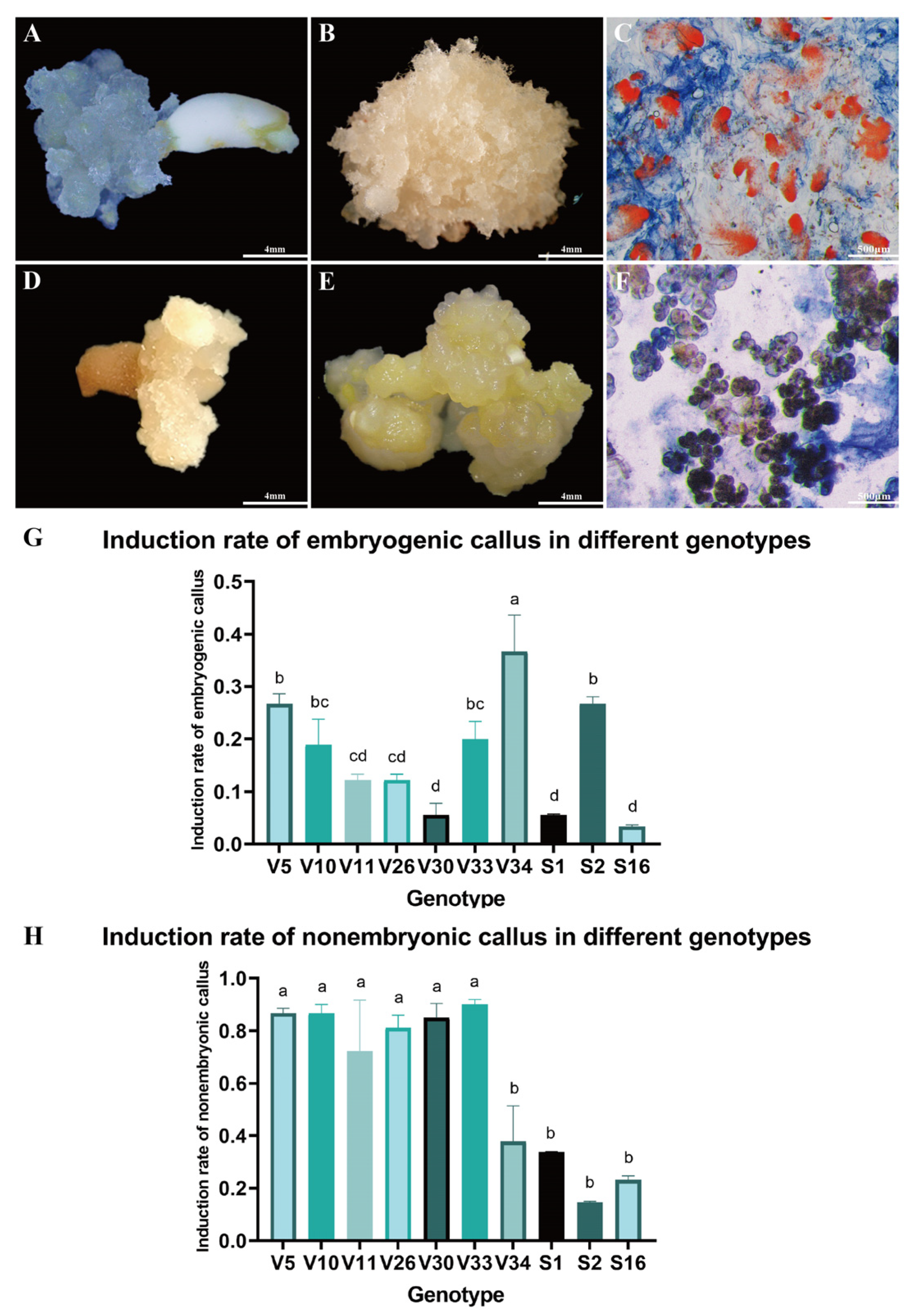
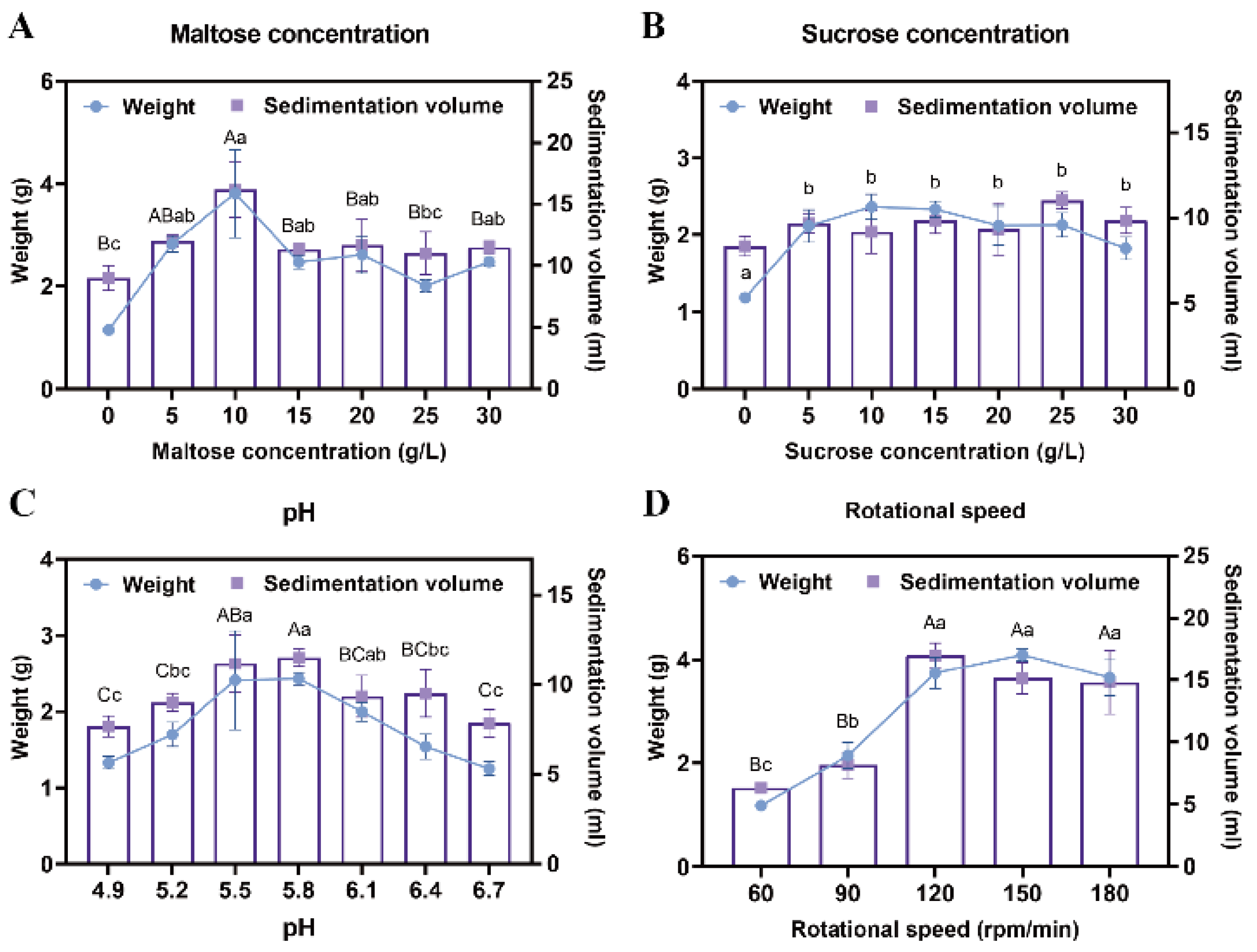
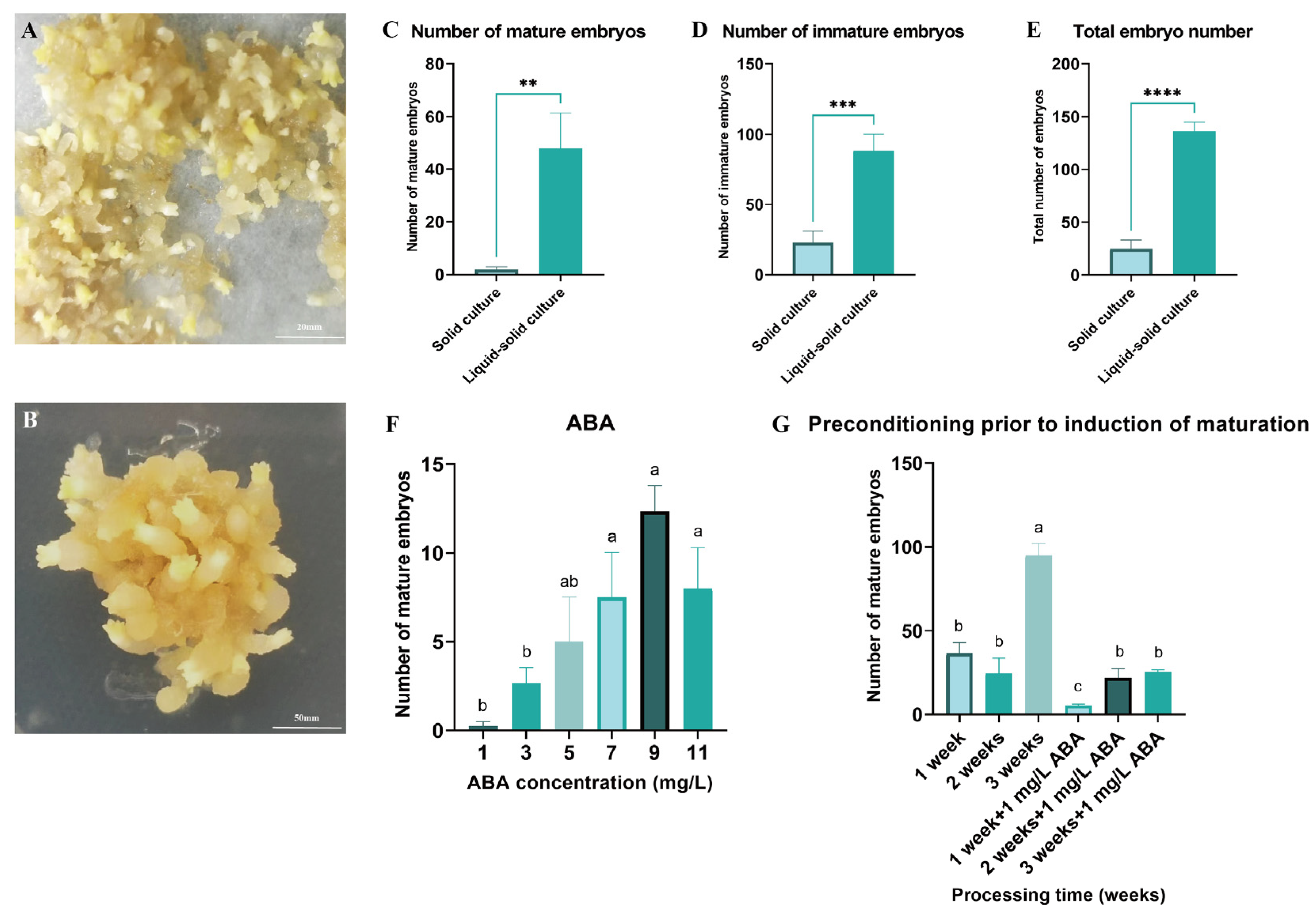
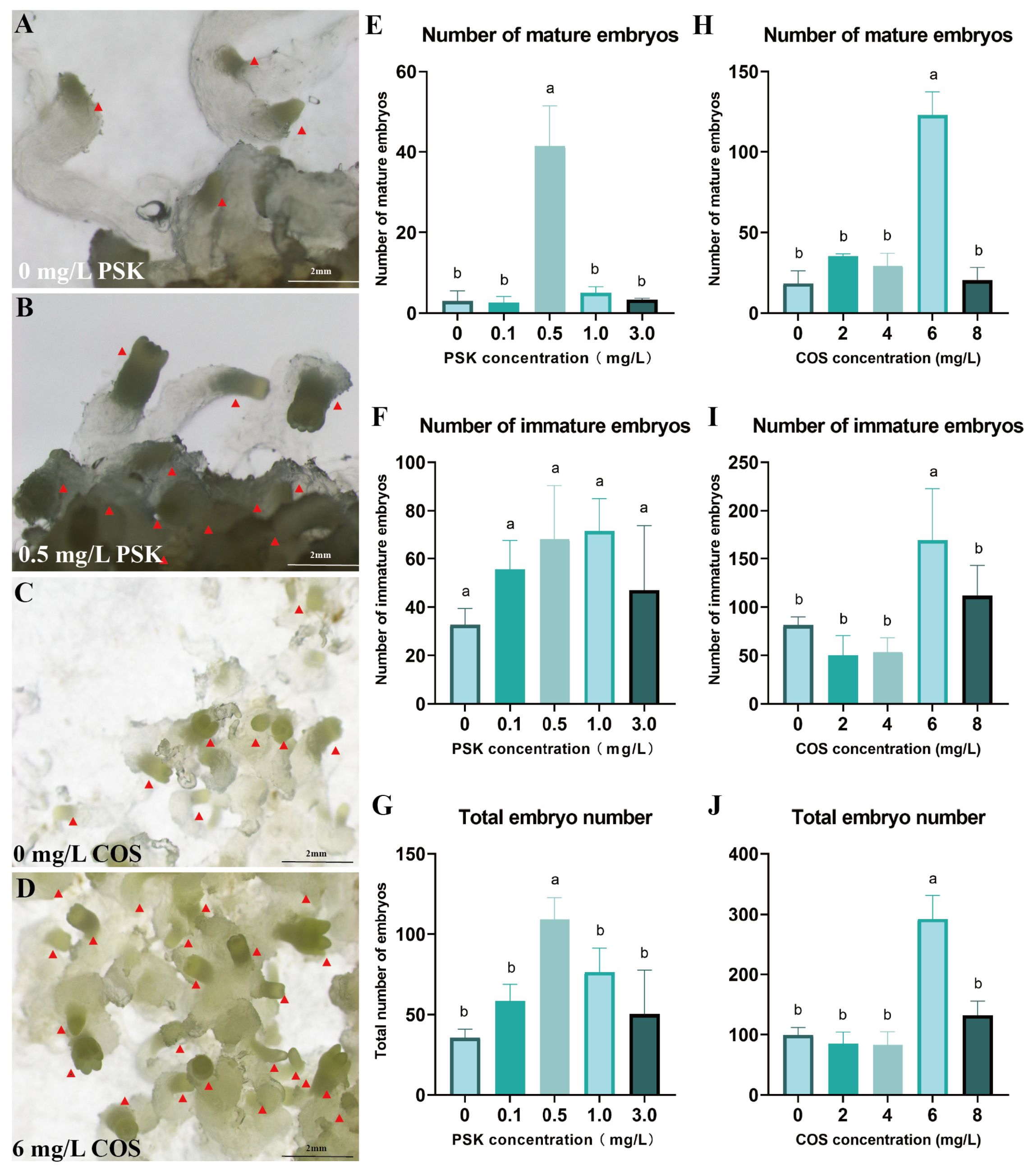

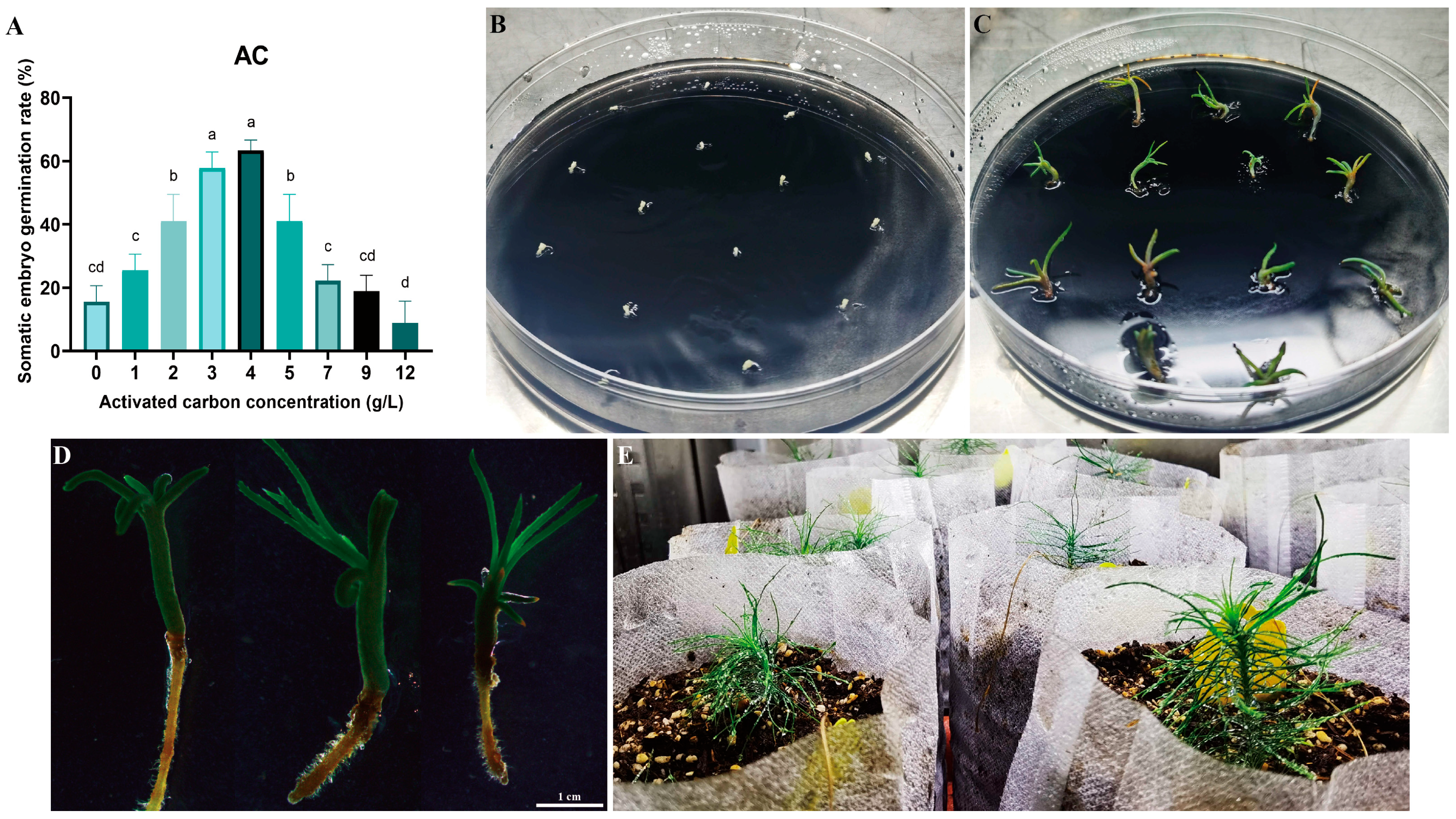
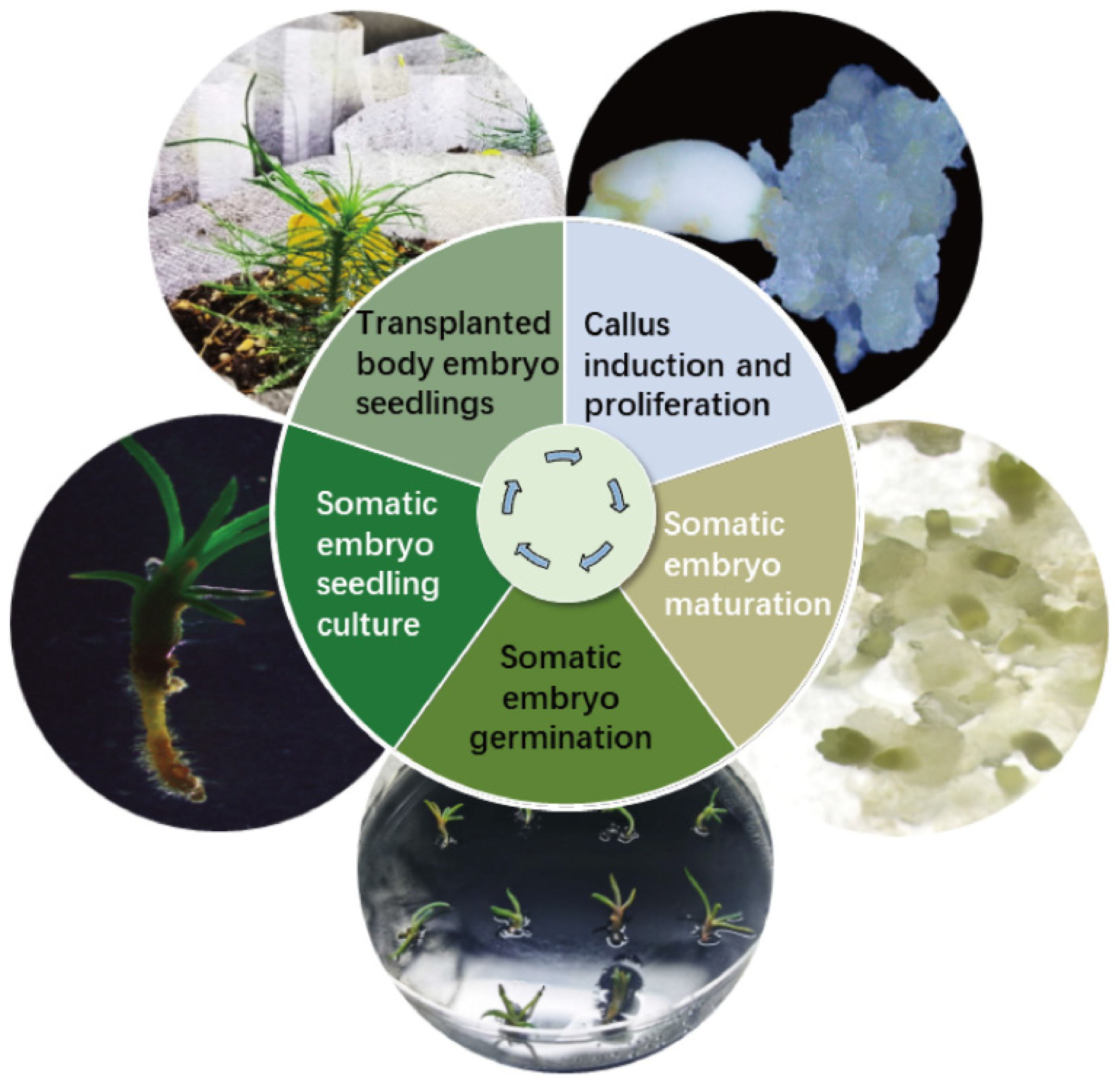
Disclaimer/Publisher’s Note: The statements, opinions and data contained in all publications are solely those of the individual author(s) and contributor(s) and not of MDPI and/or the editor(s). MDPI and/or the editor(s) disclaim responsibility for any injury to people or property resulting from any ideas, methods, instructions or products referred to in the content. |
© 2025 by the authors. Licensee MDPI, Basel, Switzerland. This article is an open access article distributed under the terms and conditions of the Creative Commons Attribution (CC BY) license (https://creativecommons.org/licenses/by/4.0/).
Share and Cite
Xu, L.; Deng, Z.; Hu, S.; Liu, Q.; Luan, Q.; Yang, C. Establishment of Efficient Somatic Embryo Maturation System of Pinus elliottii. Plants 2025, 14, 1985. https://doi.org/10.3390/plants14131985
Xu L, Deng Z, Hu S, Liu Q, Luan Q, Yang C. Establishment of Efficient Somatic Embryo Maturation System of Pinus elliottii. Plants. 2025; 14(13):1985. https://doi.org/10.3390/plants14131985
Chicago/Turabian StyleXu, Lin, Zhaolei Deng, Shan Hu, Qian Liu, Qifu Luan, and Chunxia Yang. 2025. "Establishment of Efficient Somatic Embryo Maturation System of Pinus elliottii" Plants 14, no. 13: 1985. https://doi.org/10.3390/plants14131985
APA StyleXu, L., Deng, Z., Hu, S., Liu, Q., Luan, Q., & Yang, C. (2025). Establishment of Efficient Somatic Embryo Maturation System of Pinus elliottii. Plants, 14(13), 1985. https://doi.org/10.3390/plants14131985





